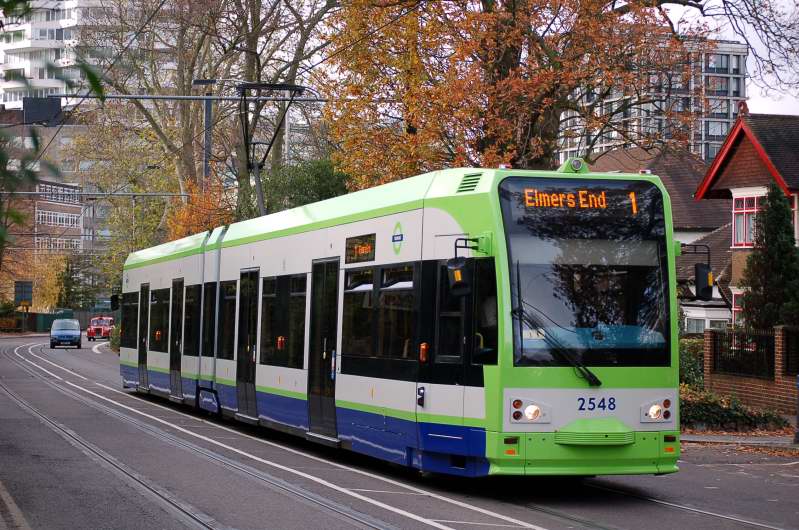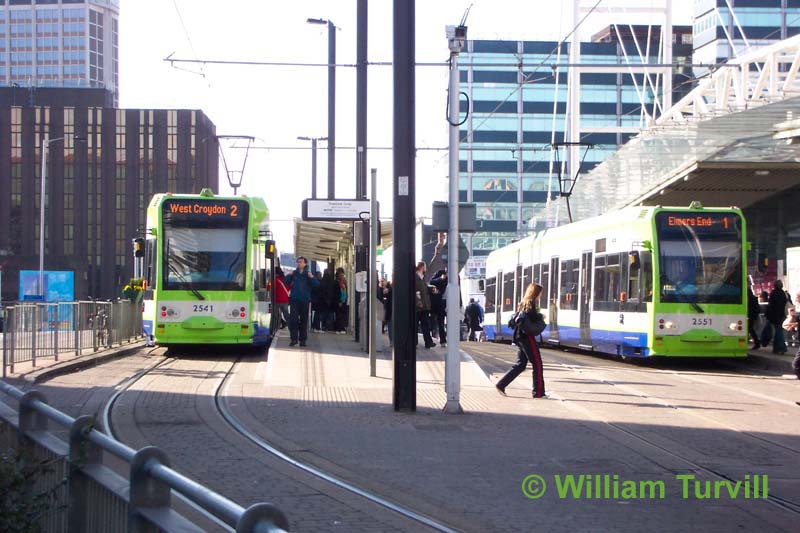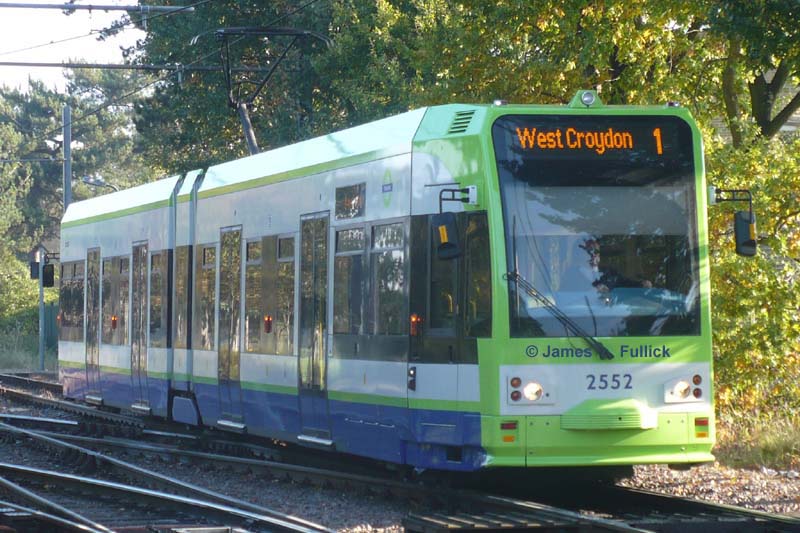 | Photo © John King. |
Home | Bus routes | Operational details | Service changes | Operators & Garages | Photo gallery
Modern tram systems are often built on disused railway alignments, and most of the length of the original Line 1 on the Croydon Tramlink falls into this category. British Rail, and their successors Connex, had run two un-profitable and pretty much un-useful shuttle services along branch lines, one being a remnant of the Mid-Kent Line between Elmers End and Addiscombe, calling at Woodside, and the other being a service between West Croydon and Wimbledon on the former Surrey Iron Railway alignment. Both services ceased in the summer 1997 timetable to allow Tramlink construction to take place, and in the event were re-opened after almost exactly three years, with a much more frequent tram service.
In the original plans, both routes were part of line 1, running between Elmers End and Wimbledon. However a need to provide a more robust timetable and additional capacity on the Wimbledon route resulted in the sections being re-organised from 23 July 2006, such that the 1 is now the shortest of the three Tramlink routes, running only between Elmers End and central Croydon. At the latter point trams run in a clockwise loop around the town centre, and trams on the 1 and 2 swap routes in Croydon.
Central Croydon is the only place where trams run along the street, and even then the only traffic they have to share roadspace with in any great quantity is buses. 2548 was seen in Addiscombe Road on the afternoon of 15 November 2008 heading out of town displaying the new green, white and blue Lodon Tramlink livery. Note the new LED destination displays, introduced just ahead of the route changes to provide improved clarity and avoid the need to order new blinds, which were of a specialised design.
 | Photo © John King. |
The network's "hub" is at East Croydon, where all trams must pass under normal operations. Three platforms are provided here, a unique feature – it is not strictly necessary as track capacity is limited by the sections either side in any case, but does provide operational flexibility, allowing trams to be reversed here in times of distruption or planned engineering works. The normal mode is to use the outside platforms, as is the case in this 27 February 2009 view of 2551 on the 1 heading for Elmers End and 2541 on the 2 having arrived from Beckenham Junction but about to turn into another 1 to Elmers End (probably the next one, as it takes about the same time to traverse the town centre loop as the interval between services!). Trams change the route number and destination on departure from East Croydon on the westbound journey, as passengers already on board will be oblivious but passengers boarding at George Street and subsequently need to know where the tram is going!
 | Photo © William Turvill. |
A brief digression on the shape of the SE London railway network might be in order here. It all started with the London & Greenwich Railway in 1836, which in fact was the first passenger railway route in London, running between London Bridge and Greenwich. In 1839 the London & Croydon railway was opened, running to what is now West Croydon, and branching off from the L&G near Bermondsey. In 1841 came the London & Brighton, branching off at Norwood Junction, and becoming the London, Brighton & South Coast Railway in 1846. Branching off this in turn, at Redhill, was the Ashford Line, from 1844.
The next development was the building of the North Kent Railway in 1849. This was originally planned as an extension of the L&G, but this would have meant tunnelling under the Royal Greenwich Observatory, and worries about vibrations from passing trains affecting observations led to it being diverted in a generous curve via Lewisham and Blackheath, to rejoin the intended route from Charlton and Woolwich onwards. (Subsequently the original route via Maze Hill has nonetheless been built, on a different alignment under Greenwich town centre and the Naval College.) To complement it, the Mid Kent Railway was conceived, branching off at Lewisham by a sharp curve and initially heading southwards, intended then to curve gradually east to the middle of Kent.
However, construction was overtaken by events, namely the more direct South East Mainline via Grove Park, Orpington and Sevenoaks, which later became the South Eastern Railway – a route originally rejected due to the need for a tunnel at Sevenoaks, which is the longest in the south of England. Thus construction of the MKR in its original form was abandoned at New Beckenham, and a sharp kink to the west was introduced to take trains to a revised terminus at Addiscombe, something of an anticlimax by all accounts. This opened in 1864, and branches at Elmers End (to Hayes) and Woodside (to connect with the Oxted Line at Sanderstead, opening in 1885) were added. The branch from Woodside to Sanderstead was never a huge success and was finally closed by British Rail on 13 May 1983. The branch to Hayes became much the main route, with the service between Elmers End and Addiscombe reduced to a shuttle service (although with some through services at peak hours).
 | Photo © James Fullick. |
Now the route between Elmers End and Woodside has been converted to tram operation, although the section to Addiscombe has been abandoned. 2552 is seen here at Arena on the former railway alignment, just crossing the junction where the new branch to Beckenham joins.
Instead of running into the old Addiscombe station – which has now been demolished for housing – trams follow the Sanderstead branch alignment as far as Addiscombe Road. While the old branch was pretty useless as it missed Croydon, the obvious major traffic objective in the area, Tramlink was able to make good use of this alignment by running trams up onto the Addiscombe Road in order to serve Croydon Town Centre. In addition, extra stops were added at Arena (above), Blackhorse Lane (at the former junction of the Addiscombe and Selsdon branches) and Addiscombe (on the site of the former Bingham Road station on the Sanderstead branch).
Line 1 (and line 2) originally ran every 10 minutes during the daytime on Mondays to Saturdays, but reduced to half hourly in the evenings and on Sundays. Apparently this was drawn up before the advent of Sunday trading! It is a disgrace that for years nothing was done about this, but shows the perils of tightly specified and controlled contracts where it can be difficult to get any changes agreed. But following the takeover of Tramtrack Croydon (the consortium responsible for building and running the system) by TfL the timetable has been improved. Trams now run every 12 minutes during the day on Mondays to Saturdays and every 15 minutes at other times, except that the Monday to Friday morning peak service is increased to every 10 minutes using one of the three maintenance spares.
Navigation
| Previous | Next | |
| Chronologically | 169 | 199 |
| Numerically | W16 | Line 2 |
Photo Gallery | Bus route list | Operational details | Service changes | Operators & Garages